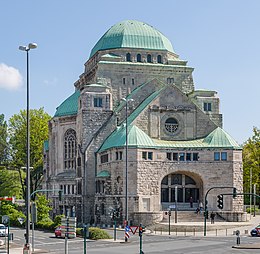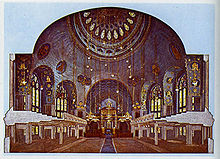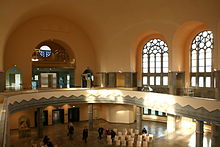Old Synagogue (Essen)
The old synagogue (initially also called the synagogue at Steeler Tor ) is now the house of Jewish culture in Essen . It is located in the city center at Steeler Strasse 29, near Essen's town hall .
The facility, which was reopened as the House of Jewish Culture on July 13, 2010 after renovation, is housed in the former synagogue building of the pre-war Jewish community. The synagogue and the adjoining rabbi’s house were completed in 1913, after a two-year construction period, according to plans by the architect Edmund Körner . Today the building is one of the largest and best preserved architectural testimonies of pre-war Jewish culture in Germany.
History of the synagogue

The beginnings
Due to the lack of space in the previous building on Gerswidastraße, the Jewish community of Essen, represented by its first rabbi , the reform-oriented Salomon Samuel , had the architect Edmund Körner plan a representative and self-confident new synagogue in 1911 that would facilitate the integration and recognition of Jews in Germany during the Second German Empire Should express. In the middle of the city center, the house was meant to symbolize the arrival of Judaism in German society; With regard to the ornamental decoration using the tradition of Judaism, in particular the symbols to be used for the mosaics and stained glass, the architect sought advice from Salomon Samuel. On September 25, 1913, what was then called the New Synagogue was inaugurated. For only 25 years it was the cultural and social center of a community of around 4,500 members in 1933. It had a main room with a capacity of over 1,500 people, with several galleries, an organ and a large bima area (which was also often used for concerts), a weekday synagogue, teaching rooms, a community hall, a secretariat, a library, a garden and rabbi and cantor apartments in the Rabbi house built to the east.
time of the nationalsocialism
On the night of November 9-10, 1938, during the November pogroms , the interior of the synagogue was badly damaged by arson. Their appearance remained almost intact. Due to the massive construction made of reinforced concrete, the National Socialists could not tear down the building contrary to their plans, and demolition was impossible because of the surrounding houses. The building survived the Second World War without major damage.
From the post-war period to the renovation in 2008
From 1945 to 1959 the synagogue stood unused as a ruin on the edge of downtown Essen. In 1959, the new post-war Jewish community, which had previously used the former rabbi's house as a center, decided to build their new synagogue , which still exists today, on the corner plot of Ruhrallee / Sedanstraße. In the same year, the city of Essen acquired the former synagogue and set up a museum for industrial design there in 1960/61 , the Haus Industrieform . For this purpose, all remaining synagogue furnishing elements were removed. A room that was completely changed inside and no longer reminiscent of the synagogue era was created in a sober functional form, in keeping with the zeitgeist of that time. In 1979 a fire caused by a short circuit damaged the design exhibition. This event and a changed attitude towards dealing with this place finally prompted the City Council of Essen to establish the Old Synagogue here in 1980 .
The internationally renowned Israeli artist Naftali Bezem , who u. a. designed the wall relief in the entrance hall of the Yad Vashem state memorial in Jerusalem in memory of the murdered Jews of Europe during the Shoah and the coffered ceiling of the reception hall of the residence of the Israeli president, the city of Essen gave a copy of the volume published by Edmund Körner in 1914 on the Synagogue (see literature), when he paid an official visit to the city of his childhood at the invitation of the Mayor of Essen, Horst Katzor , in order to participate in the deliberations on the renovation and future purpose of the now so apostrophized Old Synagogue as a house of Jewish culture in Essen . Naftali Bezem, son of the last sexton before the destruction of the Essen synagogue during the November pogroms in 1938 , donated a ten-color screen print as a supplement to help finance a facsimile reprint of this volume; this limited new edition was published in 1980. In the spring of 1992, the Folkwang Museum dedicated a comprehensive exhibition to the artist Naftali Bezem in the Old Synagogue in Essen.
From 1986 to 1988 the interior of the synagogue was partially reconstructed with funds from the state of North Rhine-Westphalia . During this time, from 1986 to 1994, the historian Michael Zimmermann also worked here on Jewish life in Essen between 1800 and 1933.
Until September 2008, the start of the latest renovation work, the Old Synagogue saw itself as an open meeting place and a political documentation forum. It offered numerous events to encounter Jewish culture and religion as well as historical and contemporary Jewish life. These included guided tours through the permanent exhibition Stations of Jewish Life for schoolchildren or adult groups, teaching houses on aspects of Jewish religious practice and lifestyle for children and young people, guided tours through the building on the architecture and its once Jewish significance. A Torah teaching house intended for adults dealt with traditional Jewish texts. In addition, the Old Synagogue was a discussion platform for central political and social issues of the present and future with a regular series of lectures. School classes could also visit teaching houses there to sharpen their political senses. The Old Synagogue also served as a venue for concerts, theater performances, readings and other cultural events.
Construction and equipment
To this day, the Old Synagogue in Essen is the largest free-standing synagogue building north of the Alps, and in terms of space even larger than the New Synagogue in Berlin . The mighty free-floating dome is 37 meters high. In total, the building is 70 meters long.
The synagogue integrates traditional Jewish-oriental with occidental-christian elements both in the layout and in the interior architecture. The design of the main room in particular shows influences from the late Art Nouveau .
The three large entrance doors to the synagogue were adorned with eighteen medallions with Jewish motifs. The six large windows of the synagogue showed pictorial representations of the Jewish holidays : Sabbath , Passover , Shavuot , Rosh Hashanah , Yom Kippur and Sukkot .
History of the rabbinical house
The rabbi's house attached to the synagogue , which has also been a listed building since 1985, was also built at the same time according to plans by the architect Edmund Körner. It was set on fire during the pogrom night in November 1938 and the interior was destroyed in the process. After the war, the rabbi's house was initially used as a community center by the small post-war Jewish community. In 1959 they sold the synagogue and its outbuildings to the city of Essen and built a new community center on the site of the Jewish youth home on Sedanstrasse, which was also destroyed in 1938. In 1962, the Essen city archive moved into the rabbi's house , which moved to a new building at the Luisenschule at the beginning of 2010 . Then the old rabbi's house was completely refurbished, and some traces of fire were discovered, which probably come from the night of the pogrom. The cost of the entire renovation of around 2.7 million euros was borne by the economic stimulus package II . The new tenants of the house moved in in 2011. These are the University of Duisburg-Essen and the Salomon Ludwig Steinheim Institute for German-Jewish History.
The old synagogue today

On February 27, 2008, the Essen City Council decided to develop the Old Synagogue into a house of Jewish culture . For this purpose, renovations were carried out inside in order to gain new exhibition space. The outdoor area was redesigned as Edmund-Körner-Platz in the ensemble with the neighboring Old Catholic Church of Peace . Since then, it has no longer been possible to drive from Bernestraße onto Steeler Straße. Since September 2008 the house was closed due to the renovation.
The official reopening took place on July 13, 2010. A house was created for an intercultural encounter with Jewish culture. There are five different exhibition areas, spread over the ground floor, the gallery and the mezzanine above , providing information on the sources of Jewish traditions, Jewish festivals and the history of the Jewish community in Essen. The five areas focus on sources of Jewish tradition , history of the house , history of the Jewish community in Essen , on Jewish festivals and the Jewish way of life . Pictures of Jewish celebrities are shown in a staircase.
The state of North Rhine-Westphalia contributed around 80 percent of the total costs for the renovation and exhibition of almost 7.8 million euros. There were also larger private donations. This enabled the staircase to be laid out generously with transparent entrance doors. The interior was given a new color scheme in apricot and lilac, the size of the main room and the incidence of light through the windows offer visitors a surprising effect.
The Thursday talks on politics, culture and society , which have been held since 1994, have a long tradition , at which current and long-term, historical and contemporary topics are publicly discussed on the first Thursday of each month (excluding holiday periods).
management
From 1980 to January 1988, the house was managed by the historian and educator Angela Genger , who then took over the management of the Düsseldorf memorial . Edna Brocke , who has headed the Old Synagogue and thus the House of Jewish Culture since 1988 , was bid farewell on March 27, 2011. Her successor is the Swiss historian Uri Kaufmann , who took office on September 1, 2011.
Exhibitions (selection)
- 2010: Famous and well-known Jewish magicians
- 2012: secretly scary. Sculptures and Judaica by Rachel Kohn
- 2013: Grigory Berstein. Falling and flying. Painting and objects
literature
- Salomon Samuel (edit.): History of the Jews in the city and synagogue district of Essen from the incorporation of Essen into Prussia (1802) to the construction of the synagogue at Steeler Tor (1913). Festschrift for the consecration of the synagogue. Essen 1913 (with a color drawing by Fritz Lewy and two pictures).
- Richard Klapheck : The new synagogue in Essen ad Ruhr. Built by Prof. Edmund Körner. (= The architecture of the 20th century. Special issue 13). Wasmuth, Berlin 1914 digitized .
- Reprint: The synagogue in Essen. Society for Christian-Jewish Cooperation e. V., Essen 1980. (with enclosed 10-color screen print The Last Shabbat (1980) by Naftali Bezem).
- Richard Klapheck: The New Synagogue in Essen. In: Journal of the Rheinischer Verein für Denkmalpflege und Heimatschutz , Volume 21, Issue 1, June 1928, pp. 108–117.
- Elfi Pracht-Jörns: The new synagogue in Essen. (= Rheinische Kunststätten , Volume 549.) Rhenish Association for Monument Preservation and Landscape Protection , Cologne 2013, ISBN 978-3-86526-095-6 .
- Frank Maier-Solgk, Thomas Maier (photos): Old Synagogue Essen. House of Jewish Culture. , Stadtwandel, Berlin 2010, ISBN 978-3-86711-159-1 (= The New Architecture Guide , Volume 164).
- Old Synagogue (ed.): A house that remains. On the occasion of 20 years of ALTE SYNAGOGE Essen, Essen 2000
- Old Synagogue Essen (Ed.): Yesterday Synagogue - House of Jewish Culture Today, Essen 2011
- Old Synagogue Essen (Ed.): Old Synagogue Essen - House of Jewish Culture. The permanent exhibition, Essen 2016
Web links
- Homepage of the Old Synagogue
- Old Synagogue Monument (PDF; 964 kB)
- The Old Synagogue on the website of the NRW Foundation
- Description of this sight on the route of industrial culture
Individual evidence
- ^ A b Richard Klapheck : The new synagogue in Essen ad Ruhr. Built by Prof. Edmund Körner. (= The architecture of the 20th century. Special issue 13). Wasmuth, Berlin 1914, pp. 17-20 ( digitized version ).
-
^ Museum Folkwang Essen (ed.), Gerhard Finckh (ed.): Naftali Bezem. An exhibition by the Museum Folkwang in the Old Synagogue Essen 21.2.-5.4. 1992. Essen 1992.
with the articles Everyday Synagogue and Hoffnungsstrasse. Memories of Essen in the 1930s by Michael Zimmermann , Naftali Bezem - an Israeli artist by Edna Brocke , Whom does your own story dismiss? by Matthias Kohn and Naftali Bezem by Gerhard Finckh - ↑ Shadow of Memory. Works by Naftali Bezem in the Old Synagogue in Essen. In: Westdeutsche Allgemeine Zeitung of February 22, 1992.
- ↑ Searching for traces in the rabbi's house. In: Westdeutsche Allgemeine Zeitung of July 31, 2010 (Essen local section).
- ^ Homepage City of Essen Events , accessed on March 8, 2013
Coordinates: 51 ° 27 '23 " N , 7 ° 1' 0" E






